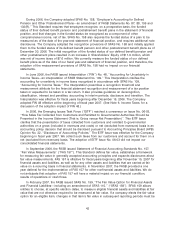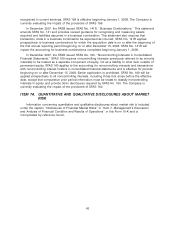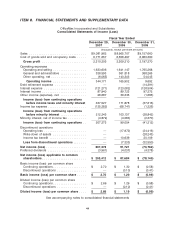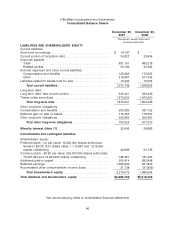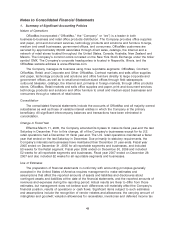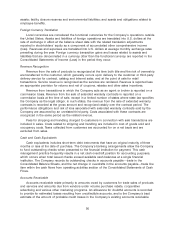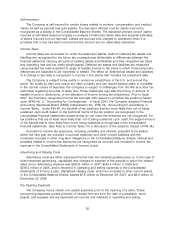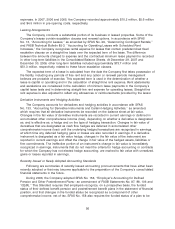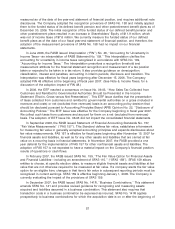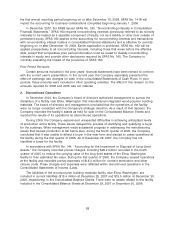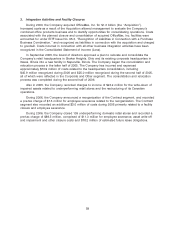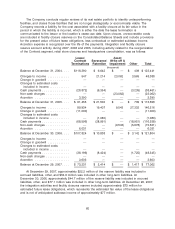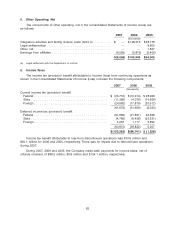OfficeMax 2007 Annual Report Download - page 56
Download and view the complete annual report
Please find page 56 of the 2007 OfficeMax annual report below. You can navigate through the pages in the report by either clicking on the pages listed below, or by using the keyword search tool below to find specific information within the annual report.Property and Equipment
Property and equipment are recorded at cost. The Company calculates depreciation using the
straight-line method over the estimated useful lives of the assets or the terms of the related leases.
The estimated useful lives of depreciable assets are generally as follows: building and
improvements, 5 to 40 years; furniture and equipment, 1.5 to 5 years; and machinery, equipment
and delivery trucks, 5 to 10 years. Leasehold improvements are amortized over the lesser of the
term of the lease, including any option periods that management believes are probable of exercise,
or the estimated lives of the improvements, which generally range from 5 to 15 years.
Long-Lived Asset Impairment
In accordance with SFAS No. 144, ‘‘Accounting for the Impairment or Disposal of Long-Lived
Assets,’’ long-lived assets, such as property, plant, and equipment, capitalized software costs and
purchased intangibles subject to amortization, are reviewed for impairment whenever events or
changes in circumstances indicate that the carrying amount of an asset may not be recoverable.
Recoverability of assets to be held and used is measured by a comparison of the carrying amount
of an asset to the estimated undiscounted future cash flows expected to be generated by the asset.
If the carrying amount of an asset exceeds its estimated future cash flows, an impairment charge is
recognized equal to the amount by which the carrying amount of the asset exceeds the fair value of
the asset. Assets to be disposed of are separately presented in the Consolidated Balance Sheets
and reported at the lower of the carrying amount or fair value less costs to sell, and are no longer
depreciated.
Goodwill and Intangible Assets
The Company accounts for goodwill and other indefinite life intangible assets in accordance
with SFAS No. 142, ‘‘Goodwill and Other Intangible Assets.’’ Goodwill represents the excess of
purchase price and related direct costs over the value assigned to the net tangible and identifiable
intangible assets of businesses acquired. Goodwill and intangible assets with indefinite lives are not
amortized, but are tested for impairment at least annually, or more frequently if events and
circumstances indicate that the asset might be impaired, using a fair-value-based approach. An
impairment loss is recognized to the extent that the carrying amount exceeds the asset’s fair value.
This determination is made at the reporting unit level and consists of two steps. First, the Company
determines the fair value of a reporting unit and compares it to its carrying amount. Second, if the
carrying amount of a reporting unit exceeds its fair value, an impairment loss is recognized for any
excess of the carrying amount of the reporting unit’s goodwill over the implied fair value of that
goodwill. The implied fair value of goodwill is determined by allocating the fair value of the reporting
unit in a manner similar to a purchase price allocation in accordance with SFAS No. 141, ‘‘Business
Combinations.’’ The residual fair value after this allocation is the implied fair value of the reporting
unit goodwill. The Company completed its annual assessment in accordance with the provisions of
SFAS No. 142 in the first quarters of 2007 and 2006, and concluded there was no impairment.
Intangible assets represent the values assigned to trade names, customer lists and
relationships, noncompete agreements and exclusive distribution rights of businesses acquired.
Trade name assets have an indefinite life and are not amortized. All other intangible assets are
amortized on a straight-line basis over their expected useful lives, which range from three to
20 years. (See Note 10, Goodwill and Intangible Assets, for additional information related to
goodwill and intangible assets.)
Investments in Affiliates
Investments in affiliated companies are accounted for under the cost method if the Company
does not exercise significant influence over the affiliated company. At December 29, 2007 and
52


